The common belief is that everyone is on a path toward homeownership. But is this really the case? A study by Knightvest, a real estate investment and property management firm, challenges this notion. They found that nearly 60% of renters actually prefer renting, while only 40% rent because homeownership is out of their financial reach. According to a Yahoo Finance article, many opt for apartment living over buying a home for these reasons:
- The steep cost of owning a home.
- The convenience of having fewer maintenance and repair tasks.
- The freedom to relocate and move around more easily.
This insight shifts the perspective on apartment living. You see, it’s not always a matter of necessity but often a choice for a simpler, more flexible lifestyle. As a result, more and more people are choosing apartment living, and apartment-styled living is on the rise.

Choosing Small Pets for Apartment Living: Key Benefits and Considerations
Selecting the right pet goes beyond personal taste; indeed, it’s a crucial choice that impacts both your lifestyle and the pet’s welfare. Initially, key factors such as the pet’s space requirements, activity level, size, and temperament must be considered. Particularly, this becomes essential for those living in apartments or tiny homes, a point underscored by a LinkedIn article on pet selection. Consequently, our guide zeroes in on pinpointing pets that are well-suited for compact spaces. Furthermore, we spotlight pets that flourish in close quarters, thereby guaranteeing a cozy and harmonious living environment for both of you.
Top 5 Ideal Pets for Small Spaces: A Comprehensive Guide
This guide will explore the best pets for apartment living, delving into the ideal choices within various animal categories. Furthermore, we’ll cover the top cat and dog breeds tailored for small spaces, highlighting their care requirements. Additionally, we’ll discuss the best fish for apartment dwellers, including tips for setting up and maintaining a compact aquarium. To add on, the comparison between hamsters and guinea pigs as suitable small pets will be examined alongside their specific care needs. Lastly, we’ll identify the top bird breeds that thrive in apartment settings and outline their care essentials. From cats and small dogs to fish, small furry pets, and birds, this article will provide a comprehensive breakdown of the best pets for apartment living. So, let’s dive in.
Cats: Ideal Companions for Apartment Living
House cats are excellent companions for apartment living, but some breeds stand out as particularly well-suited for such environments. For instance, the British Shorthair is an outstanding choice, celebrated for its calm demeanor and low maintenance. Additionally, these cats thrive in the quiet and confined spaces of an apartment or tiny home. Also, an added perk of this breed is their affectionate nature, balanced with an independent streak that makes them perfect for indoor living.
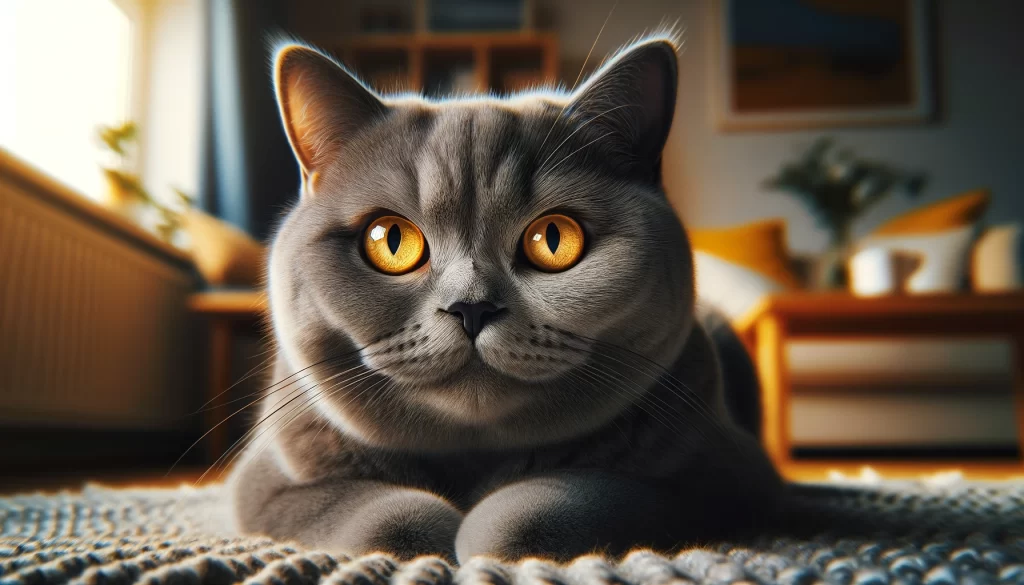
Another top choice for apartment dwellers is the Scottish Fold. This breed, notable for its unique folded ears, possesses a very gentle nature. Moreover, Scottish Folds excel in indoor settings, adapting seamlessly to apartment life without needing extensive space. Furthermore, they enjoy the company of their human companions, making them ideal roommates in smaller homes.

Finally, the Ragdoll ranks high on our list of the best cat breeds for apartment living. Notably, Ragdolls are less active and are known for their docile and placid nature, making them perfect for small indoor spaces. Additionally, their friendly demeanor ensures they blend well into cozy environments, embodying the ideal indoor pet qualities.

Cat Adaptability in Apartments: Thriving in Compact Living Spaces
Cats stand out as ideal apartment pets due to their exceptional ability to adapt to indoor living. What’s more, this adaptability springs from their independent and self-sufficient nature, perfectly suited to the constraints of indoor spaces.
Not to mention, their territorial behavior plays a crucial role in their comfort with apartment life. Unlike dogs, which often need vast outdoor areas for exploration and exercise, cats are perfectly happy within smaller, well-defined territories. As a matter of fact, they find joy and stimulation in apartment life—whether it’s exploring various nooks, climbing furniture, or simply enjoying the view from a window.
Another plus, cats’ need for outdoor exercise is minimal compared to other pets. Engaging in indoor play, such as chasing toys or interactive games with their owners, provides them with both physical exercise and mental stimulation. Consequently, this behavior significantly reduces their need for outdoor access and underscores their suitability for living in apartments.
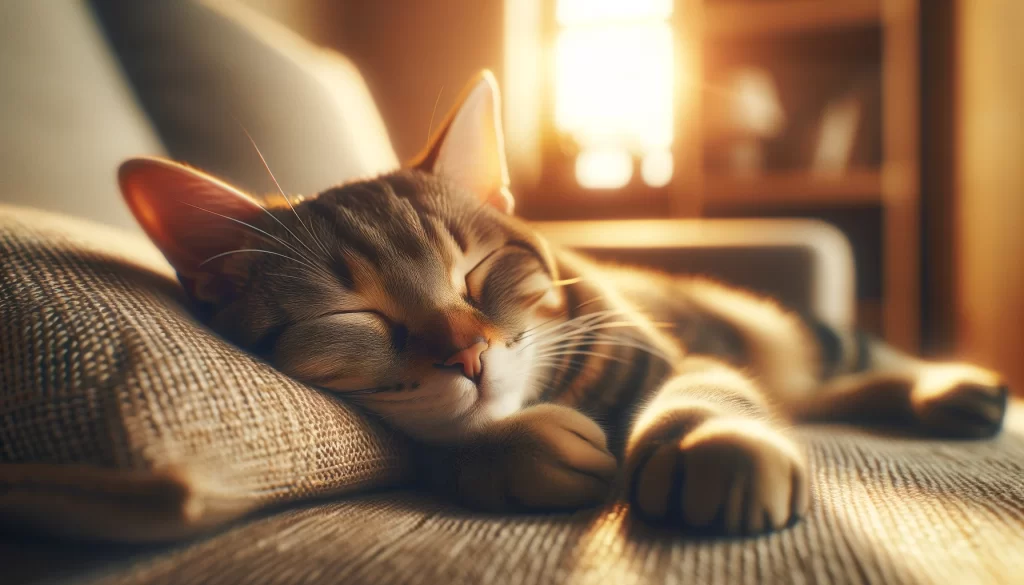
On top of that, another plus is cats’ natural sleeping patterns. Likewise, with an average of 13 to 14 hours of sleep daily, they are less prone to boredom or restlessness in confined spaces.
Cats’ cleanliness and grooming habits also enhance their compatibility with apartment living. In addition to this, they instinctively use a litter box and maintain their hygiene through self-grooming, making them low-maintenance companions.
These combined traits—territorial satisfaction, minimal exercise requirements, extensive sleep habits, and inherent cleanliness—make cats capable and thriving participants in the indoor, compact lifestyle of apartment dwellers. They not only adjust but also enrich the living environments of their human companions, making a small space feel more like a home.
Essential Cat Care: Litter Boxes, Feeding, and Grooming
Caring for cats is relatively straightforward, especially when it comes to litter boxes, feeding, and grooming—underscoring their status as low-maintenance pets, particularly in comparison to other animals.
Litter Boxes: One of the hallmarks of cat care is managing their litter box. Cats instinctively seek out sandy or granular materials to relieve themselves, making litter box training typically straightforward. For apartment dwellers, maintaining a clean litter box is essential to keep the living space odor-free and hygienic. It’s recommended to scoop the litter box daily and change the litter completely on a regular basis to ensure cleanliness and comfort for both the cat and the owner.
The Litter Robot simplifies litter box maintenance by automatically separating cat waste from clean litter, minimizing the need for daily clean-up. Its enclosed design and waste storage system excel in controlling odors, enhancing litter efficiency, and facilitating health monitoring. Additionally, it helps reduce litter tracking and spillage, making it an ideal solution for homes with multiple cats.
Feeding: Cats require a balanced diet. From kittens to senior cats, a variety of commercial cat foods are formulated to meet these needs. Establishing a regular feeding schedule is important to maintain optimal health and prevent overfeeding. Fresh water should always be available and refreshed daily to encourage hydration.
Grooming: Cats benefit from grooming sessions with their owners despite their self-grooming habits. Long-haired cats may need daily attention to prevent mats and tangles, while short-haired breeds only need weekly brushing to remove loose fur.
According to passionatedog.com, in addition to strengthening the bond between cat and owner, regular grooming is also an excellent opportunity to check for skin issues or parasites on your pet.
Compared to many other pets, cats require little maintenance. Litter box habits suit them well for indoor living since they don’t require daily walks or outdoor exercise. Their grooming needs are modest, and their grooming needs are modest as well.
Cats are ideal companions for those looking for a furry friend without the high maintenance demands of other pets due to their ease of care and independence.
If you ever have issues with pet fur around the home, I have an article for you to read and learn about the best vacuums for maintaining pet hair.
Top Benefits of Having a Cat in a Small Apartment
Cats are great for apartment living. We’ve discussed their need for little space and low maintenance. They fit well in tiny homes. Plus, cats are independent. They can entertain themselves for hours.
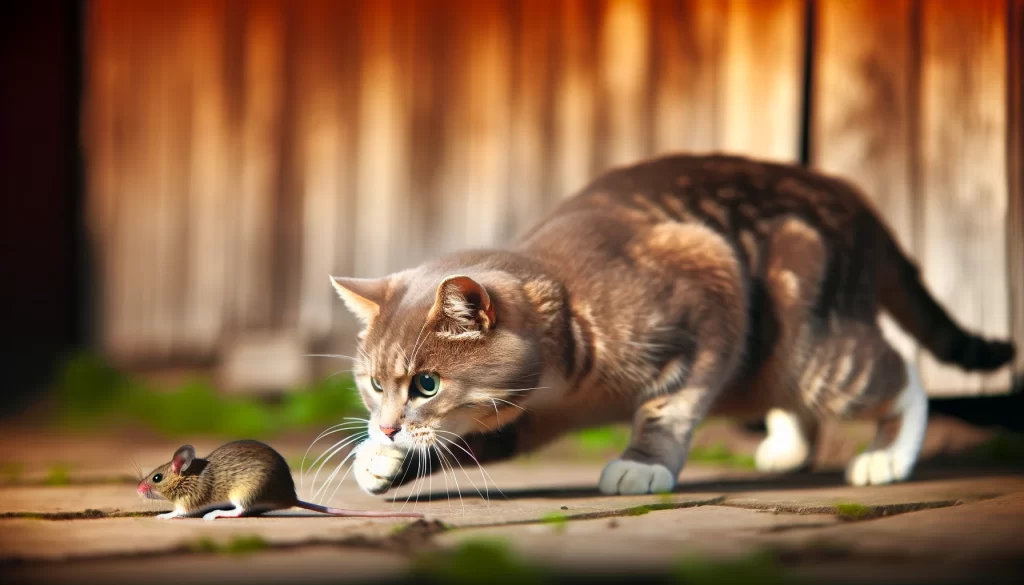
Additionaly, having a cat brings many benefits. They offer comfort and companionship. Cats also adapt well to apartment life. Earlier, we touched on their low maintenance and adaptability. Now, let’s explore more benefits.
Cats help reduce stress by offering their owners a sense of calm and relaxation. Petting a cat can lower your blood pressure and ease anxiety. Cats are also great for our mental health. Spending time with a cat can decrease loneliness and boost your mood.
Regarding pest control, cats are natural hunters. They can deter common pests like mice and insects. This pest control skill is a bonus for any apartment dweller.
In summary, cats are more than just easy to care for. They also improve our well-being by reducing stress, benefiting our mental health, and keeping our homes pest-free.
Creating a Cat-Friendly Home: Tips for Safety & Stimulation
Creating a cat-friendly apartment is key to your pet’s happiness. Moreover, cats need a safe and cozy space to feel secure and to explore. Let’s dive into some easy steps to make your apartment perfect for your feline friend, ensuring a peaceful coexistence.
Secure Windows and Balconies
Make sure windows and balconies are safe to prevent falls. Sturdy screens or nets are great for pet safety. This way, your cat can enjoy the breeze safely.
Hide Electrical Cords
Cats often chew on electrical cords. To avoid risks, tuck cords away or use protective covers.
Remove Toxic Plants and Chemicals
Watch out for harmful houseplants and chemicals. My cat, for instance, can’t resist nibbling on plant leaves or flower petals. Choose cat-safe plants and pet-friendly cleaners instead.
Provide Scratch Posts and Pads
Cats need to scratch for healthy claws and to mark territory. Its a good practice to offer various scratching posts and pads around your home. This keeps furniture safe from scratches.
Invest in a Variety of Cat Toys
Keep your cat busy with different toys. Interactive toys and puzzle feeders are great. Cardboard boxes and paper bags also work well. Try a subscription box like Meowbox for new toys each month.
Establish a Comfortable Resting Area
Set up a cozy spot for naps and relaxation. A window perch is great for bird-watching, a cat’s favorite hobby. A hammock or swing by the window can be ideal.
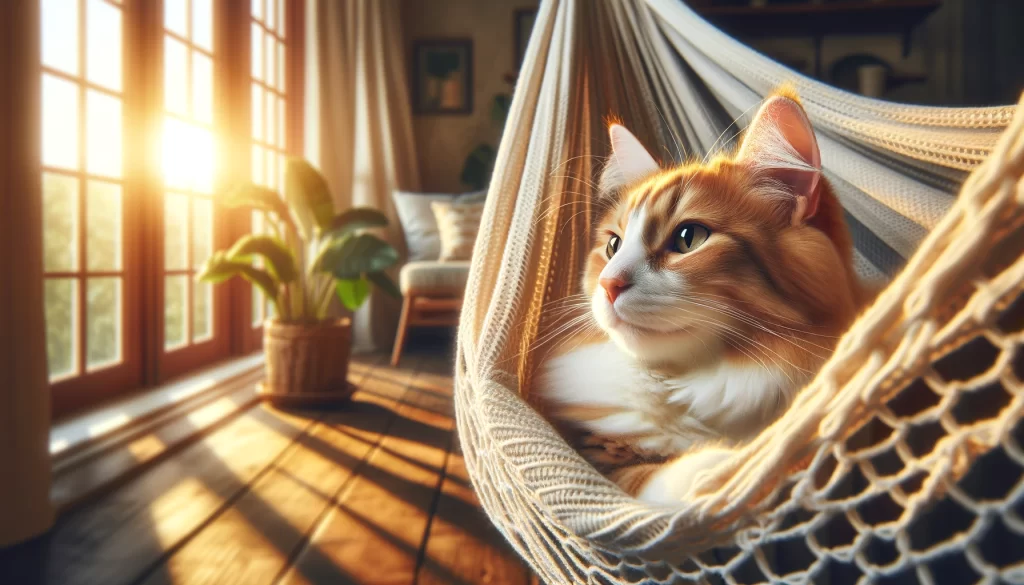
Ensure Access to Fresh Water and a Clean Litter Box
Always have fresh water available. A cat water fountain can be more enticing. Keep the litter box clean and in a discreet spot. Covered boxes or a Litter Robot can enhance privacy and control odors.
Create Vertical Spaces
Cats love high spots for a good view. Add cat trees, shelves, or wall steps for climbing and exercise.
Use Calming Aids if Needed
Help anxious cats with pheromone diffusers, soft music, or catnip. These can make your apartment more calming.
Following these steps will make your apartment a dream home for your cat. They’ll be happy, active, and healthy. Plus, you’ll enjoy a harmonious living space together.
Best Small Dog Breeds for Apartment Living: Your Guide to the Perfect Pet
Choosing the right dog for apartment living goes beyond size. It’s crucial to find a breed that’s quiet, low-energy, and easy to groom, especially if you’re interested in hypoallergenic options. Let’s dive into the ideal picks for those tight on space but big on love for furry friends.
Ideal Picks for Peaceful Apartment Living
For a serene apartment atmosphere, consider breeds that are not just small but also known for being on the quieter side:
- Boston Terriers stand out for their friendly demeanor and low grooming needs, making them perfect for compact spaces.
- Shih Tzus, with their calm nature and hypoallergenic coat, require regular grooming but are worth the effort for allergy sufferers.
- Cavalier King Charles Spaniels bring affection and beauty into any home, with their low-shedding fur needing some care to stay pristine.
- Italian Greyhounds offer a sleek look and minimal grooming, ideal for the busy apartment dweller.
- Basenjis, unique in their quietness, also boast a hypoallergenic coat that’s easy to maintain.
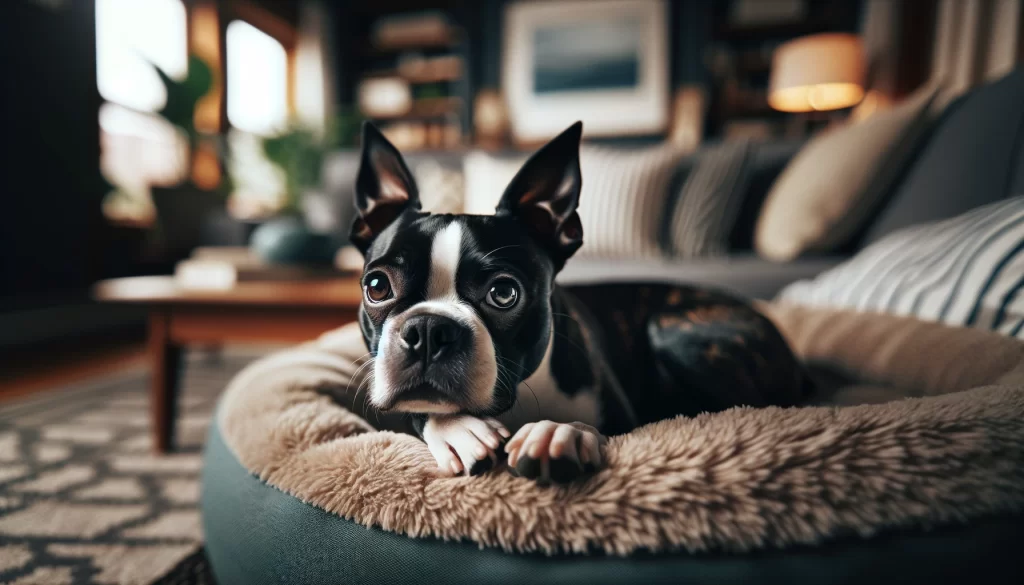
Choosing the Right Match
When picking a breed, balance is key. Opt for dogs that match your living situation by being both manageable in energy levels and not too vocal. This ensures a harmonious living environment for both pet and owner.
Simplified Care for Dogs Living In Apartments
Caring for your apartment-friendly dog involves a few key considerations:
- Exercise: Tailor activities to your dog’s energy levels; indoor games and short walks usually suffice.
- Grooming: Choose breeds with grooming needs that fit your lifestyle, whether it’s low-maintenance or hypoallergenic.
- Training: Regular training keeps barking under control and helps your pet adapt to apartment living.
Keeping Your Dog Engaged
A happy dog is an engaged dog. Use puzzle toys and playtime to keep them entertained, and don’t forget the importance of social outings like walks or trips to the dog park.

The Perks of the Perfect Pick
Choosing a dog that fits apartment living can make all the difference. Smaller, quieter, and easy-to-groom dogs not only make life easier but also ensure a peaceful coexistence in tighter spaces.
Wrapping Up: The Best Breeds for Apartment Dwellers
For those living in apartments, breeds like Boston Terriers, Shih Tzus, Cavalier King Charles Spaniels, Italian Greyhounds, and Basenjis are fantastic choices. They offer the right mix of quietness, low energy, and manageable grooming needs. By catering to their exercise, grooming, and training needs, you’ll pave the way for a fulfilling life with your small, apartment-friendly dog.
The Best Fish for Apartment Living: A Compact Guide
Small living spaces require pets that fit into compact areas while enhancing the home’s aesthetic appeal. Among the many options, fish stand out as an excellent choice. Specifically, Betta fish and other small, low-maintenance breeds offer minimal space requirements and visual appeal. This guide covers the essentials of fish care, tank setup, and the best fish types for small apartments, ensuring a peaceful addition to your living space.
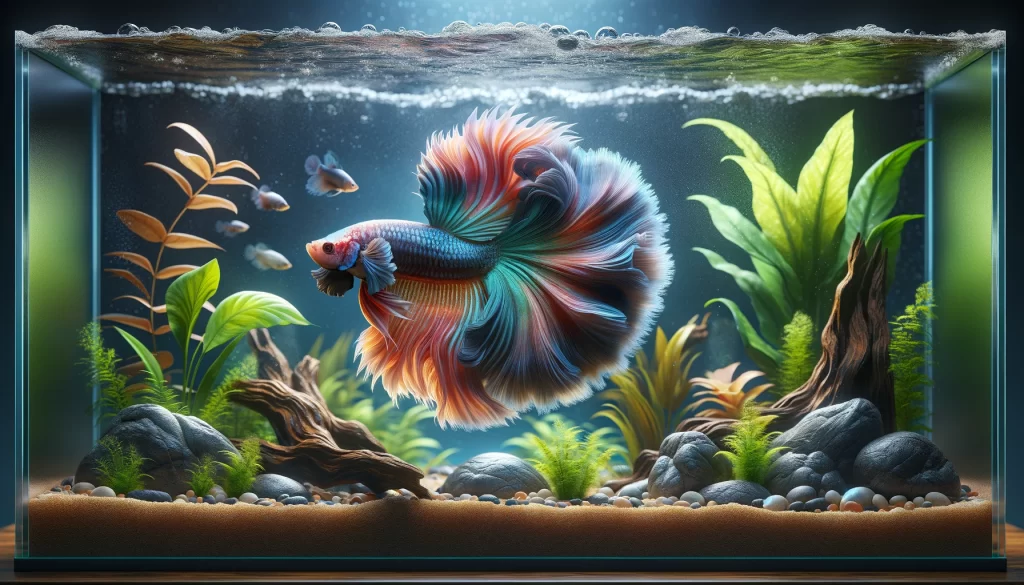
Overview: Minimal Space, Maximum Beauty
Betta fish, with their vivid colors and elegant fins, are perfect for small spaces. They, along with other small fish breeds, thrive in compact tanks that can easily fit into any apartment corner, bringing life and movement to your home without demanding much room.
Care Requirements: Simple Steps for Healthy Fish
Fish care involves basic yet crucial steps, from setting up the right tank environment to regular maintenance. Key aspects include:
- Tank Setup: Choose the right size tank (5 gallons or more for Bettas) and equip it with essential components like filters and heaters.
- Water Quality: Maintain clean water through regular changes, ensuring a healthy environment for your fish.
Perfect for Small Apartments
Fish tanks offer a unique advantage for apartment dwellers: they’re compact and create no noise. This advantage makes fish ideal pets for small living areas where space is premium and tranquility is valued.
Setting Up Your Aquarium
Creating a home for your fish begins with the proper tank setup:
- Choose a Tank: Opt for a size that fits your space and the needs of your fish. Small, low-maintenance fish require smaller tanks, making them ideal for apartments.
- Equip Your Tank: A filter and heater are essential for maintaining a stable environment. Add gravel, plants, and decorations for shelter and stimulation.
Upkeep Made Easy
Caring for fish and their tanks is straightforward:
- Feed Properly: Avoid overfeeding by giving small amounts they can consume in a few minutes.
- Clean Regularly: Perform partial water changes weekly to keep the tank clean and the water parameters stable.
Fish Types: Tranquil Companions
Choose beginner-friendly fish that bring calmness and beauty to your apartment. Alongside Betta fish, consider Guppies, Neon Tetras, and Corydoras Catfish for their ease of care and peaceful nature.

Starting Your Aquarium: Avoid Common Mistakes
Begin with research to avoid common setup errors. Ensure your tank is fully equipped and cycled before introducing fish. This preparatory step is crucial for creating a stable aquatic environment.
- By following these guidelines, you can enjoy the serenity and beauty of an aquarium in your small apartment. Fishkeeping in limited spaces adds visual appeal and a soothing presence, making it a rewarding hobby for apartment dwellers.
Hamsters or Guinea Pigs: Small but Mighty Companions

Hamsters are a top choice for those seeking a small but delightful pet companion, perfect for apartment living. Their various breeds with unique colors and personalities offer something for everyone. From the fluffy Syrian hamster to the tiny, energetic Dwarf, these little creatures significantly impact pet lovers’ hearts.
The Essentials of Hamster Care
Caring for hamsters involves a few key considerations. First, their habitat: a spacious cage that allows for burrowing and exercise is essential, ideally a minimum of 450 square inches of floor space. Their diet should be a balanced mix of hamster pellets, fresh fruits, and vegetables, with the occasional treat. Exercise is another crucial aspect, with a sturdy wheel and space to explore, ensuring they stay happy and healthy.
Why They’re Perfect for Apartment Living
Hamsters are naturally nocturnal, which means they’re most active at night. This trait makes them ideal for apartment dwellers, who are less likely to create daytime noise. Their compact cages easily fit into small spaces, making hamsters excellent pets for those with limited living areas.
Minimal Space, Maximum Joy
Setting up a home for your hamster requires little space. A well-equipped cage with bedding, a hiding spot, a water bottle, and a wheel for exercise can be comfortably placed in a small corner of your apartment. This setup ensures your hamster has everything it needs while keeping your living space uncluttered.
Easy Care and Delightful Interactions
Hamsters may be low maintenance, but they offer high rewards for interaction and entertainment. Watching them fill their cheeks with food, run on their wheel, or navigate a maze you’ve set up for them can provide endless amusement. While they’re not as hands-on as some pets, with gentle handling, they can become relatively tame, enjoying cuddles and playtime outside their cage.
Choosing Between Hamsters and Guinea Pigs
When deciding between hamsters and guinea pigs, consider your lifestyle and what you want in a pet. Hamsters are nocturnal and great for night owls or those away during the day. They require less space and can be easier to care for due to their smaller size. On the other hand, the guinea pig is larger than the hamster and more social, so it needs more space and interaction. They’re diurnal, so they’re awake during the day. Guinea pigs being active during the day might suit your schedule better if you seek more active daytime companionship.
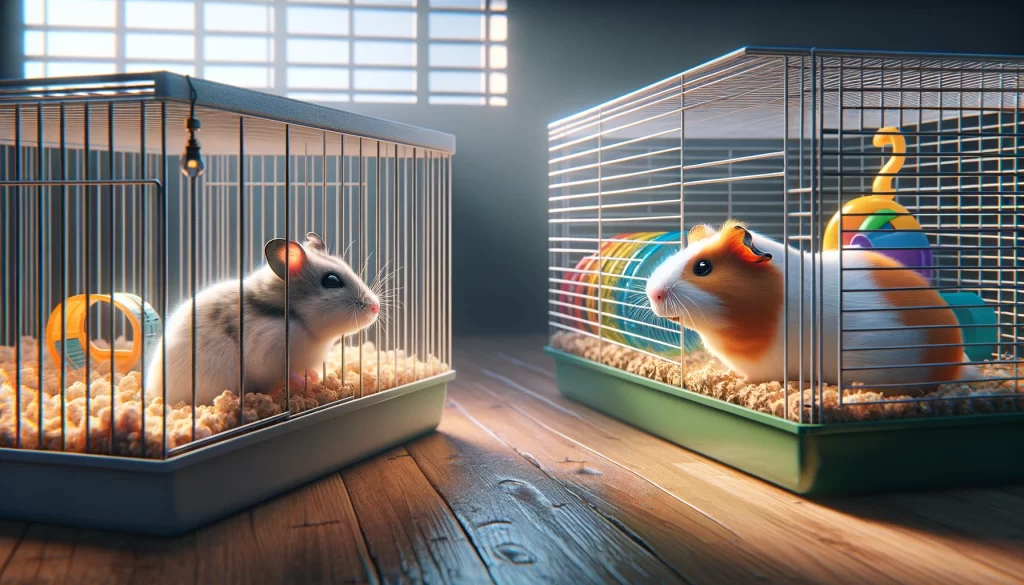
The Ultimate Apartment Pet Showdown
Both hamsters and guinea pigs can be suitable for apartment living, but their care requirements and lifestyles differ significantly. Hamsters offer the convenience of nighttime activity and minor space requirements, making them ideal for those with a more nocturnal lifestyle or limited room. Guinea pigs require more space and social interaction but can be more engaging pets during the day.
Choosing the right pet depends on your personal preferences, space, and the time you can dedicate to their care. Whether you opt for the solitary exploration of a hamster or the social chatter of a guinea pig, both can make excellent companions in their own right, bringing warmth and personality to your apartment living experience.
Birds in Small Spaces: How to Thrive with Feathered Friends
Birds make colorful and lively companions, ideal for adding a touch of nature to any small apartment. Their cheerful tunes transform an ordinary space into a vibrant living area, demonstrating that even in a small space, we can enjoy the company of feathered friends.
Bird Care: The Basics
Caring for birds involves understanding their basic needs, including a spacious cage for flight and movement, a diet rich in nutrients with various seeds, fruits, and vegetables, and regular social interaction to keep them engaged and happy. Proper care ensures that these intelligent and social creatures thrive.
Perfect for Small Spaces
One of the most significant advantages of choosing birds as pets for small apartments is their minimal space requirements. A well-placed cage only takes up a little room and adds life and joy to your space. The soothing background of bird songs creates a serene atmosphere, making your apartment feel more like home.
The Joy of Bird Ownership
Owning birds comes with numerous benefits. Beyond their beautiful songs and striking colors, birds offer companionship and the opportunity to bond with a pet. Watching their playful antics and interacting with your pet bird daily brings a unique joy that’s hard to match. They’re not just pets; they become part of the family.

Cage Setup and Care
When setting up a cage, size matters. Opt for a reasonably decent-sized cage to ensure your bird has ample space to fly and exercise. Furthermore, you should include perches at different heights and toys for mental stimulation. Ensure the cage is placed in a part of the apartment that’s free from drafts but still part of the daily activity to keep your bird engaged.
Recommended Bird Species for Apartments
Certain bird species adapt better to indoor living and are content in smaller spaces. For example, budgies, canaries, and finches are particularly suited to apartment life. Budgies are known for their friendly nature and ability to mimic speech, while canaries delight their owners with beautiful songs. Finches are visually striking and relatively easy to care for.
Ensuring a Happy Indoor Life for Your Bird
Regular interaction is key to ensuring your bird leads a happy and healthy life in an apartment setting. Spend time talking to your bird, training them, and, if possible, allowing them safe, supervised time outside their cage to explore. Maintaining a clean cage, providing a nutritious diet, and ensuring they have plenty of toys will help keep your bird content.
- Birds can be the perfect pets for small apartments, bringing color, song, and companionship into your life. With the proper care, setup, and species selection, you can ensure your feathered friend thrives, making your apartment a joyful and lively home.
Pet Ownership in Small Spaces: Your Questions Answered
Discovering the best pets for apartment living can be challenging. Our FAQ section addresses common concerns and questions, helping create a harmonious living space for you and your pet.
Can large dog breeds be happy in an apartment setting?
Yes, large dog breeds can thrive in apartments with the proper care. Daily exercise, mental stimulation, and regular outdoor walks are critical. Breeds like Greyhounds and Great Danes are surprisingly well-suited for apartment living due to their lower energy levels than smaller breeds.
How to minimize pet odors in small spaces?
Keeping your apartment free from pet odors involves regular cleaning and maintenance. For cats, clean the litter box daily. For dogs, regular baths and grooming can help. Invest in an air purifier and ensure your space is well-ventilated. Choosing pets with minimal shedding or hypoallergenic traits can also reduce odors.
What are the best pets for first-time apartment dwellers?
Betta fish, hamsters, and cats are great for first-timers due to their relatively low maintenance and space requirements. These pets offer companionship without the need for extensive pet care experience.
How do I ensure my apartment is safe for my pet?
Pet-proofing your apartment involves:
- Securing loose wires.
- Ensuring windows are safely screened and secure.
- Keeping toxic foods and plants out of reach.
Create a safe, comfortable space for your pet by providing them with their designated area with toys and a bed.
What should I consider when setting up a fish tank in a small apartment?
Consider the tank size and the type of fish you want to keep. Smaller, low-maintenance fish like bettas or guppies are ideal for apartments. Ensure you have a stable, level place to set up the tank, away from direct sunlight and drafts. Invest in a quality filter and regularly test water parameters to keep your aquatic friends healthy.
Are there any pets that are particularly good for people with allergies?
Yes, hypoallergenic pets are ideal for allergy sufferers. Consider breeds like the Bichon Frise, Sphynx cats, or hairless rat varieties. For non-furry options, fish or reptiles can be great pets without the risk of allergic reactions.
Other pet options that may do well in apartments:
- Small Reptiles: Creatures like geckos or small snakes require minimal space and can be easy to care for with the correct setup.
- Amphibians: Frogs or salamanders offer a unique pet-keeping experience and can thrive in terrarium settings, making them suitable for apartments.
- Choosing the right pet for apartment living depends on your lifestyle, time, and ability to meet the pet’s needs. Whether you opt for a furry friend, a feathered companion, or an aquatic pet, ensure you’re prepared to create a loving, comfortable home for them.
